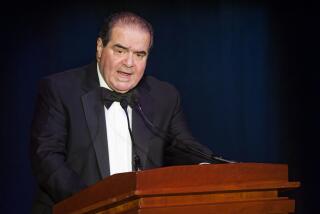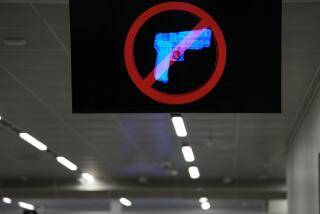High Court Upholds Family Privacy in Death Photos
WASHINGTON — The U.S. Supreme Court said Tuesday that the family of a prominent person who had died had a privacy right to object to the government’s release of photographs taken at the death scene.
In a 9-0 ruling, the court held that the Freedom of Information Act does not require the public release of four close-up photos of the body of Vincent Foster, the White House lawyer and aide to President Clinton who shot himself in 1993.
Tuesday’s decision reverses the U.S. 9th Circuit Court of Appeals and dismisses a lawsuit brought by a Los Angeles lawyer who contends that the former Clinton advisor may have been murdered.
Foster’s family has a right “to secure their own refuge from a sensation-seeking culture for their own peace of mind and tranquility,” Justice Anthony M. Kennedy said.
Washington lawyer James Hamilton, whom Foster had consulted before his death, represented his family in seeking to keep private the photos of Foster’s body.
“The family is extremely pleased with the holding by the Supreme Court,” Foster’s family said. “We hope other grieving families will benefit from the court’s decision.”
Tuesday’s decision strengthens the case against requests for the release of other photos, such as the remains of victims of the Space Shuttle disaster or the destruction of the World Trade Center in New York and, possibly, the body of race car driver Dale Earnhardt. His family has been fighting in Florida courts to block the release of autopsy photographs of Earnhardt, who was killed in a crash at the Daytona International Speedway in 2001.
At least since the assassination of President John F. Kennedy in 1963, the government has faced requests for the public release of information or photos in its files that might bear on a national tragedy. In Kennedy’s case, conspiracy theorists have continued to claim that, contrary to the Warren Commission report, he was not shot from behind by a lone assassin, Lee Harvey Oswald.
The Freedom of Information Act generally requires the federal government to make public information kept in its files. But among the many exceptions to this disclosure rule are law enforcement records that “could reasonably be expected to constitute an unwarranted invasion of privacy.”
Foster grew up in Arkansas with Bill Clinton and was a law partner in Little Rock with Hillary Rodham Clinton. He came to Washington in January 1993 and became deputy White House counsel when Clinton became president
But Foster came in for rough treatment from the start. In mid-June of that year, the Wall Street Journal’s editorial page turned a harsh light on him. In an editorial titled, “Who is Vincent Foster?,” the paper implied that he might have been leading a cover-up of the Whitewater affair in Arkansas.
“I was not meant for the job or the spotlight of public life in Washington,” Foster wrote in a note found in his briefcase after his death. “Here ruining people is considered sport.”
On July 20, after having lunch at his desk, he left the White House. Several hours later, his body was found in Fort Marcy Park in Virginia, a National Park Service property overlooking the Potomac River. He had been shot in the head, and a gun lay next to his right hand.
Investigations by the U.S. Park Police, committees of the House and the Senate and independent counsels Robert B. Fiske Jr. and Kenneth W. Starr concluded that Foster had committed suicide.
But Allan Favish, a Los Angeles lawyer, maintained there were discrepancies in the official version of what happened, and that these questions could be resolved only by the government releasing the death scene photos of Foster and the gun.
Favish had pursued the issue while working in Washington for Accuracy in Media, a conservative watchdog group, but Starr’s office refused to release the photos of the death scene. After moving to Los Angeles, Favish filed a suit in 1997 in federal court to enforce his claim under the Freedom of Information Act.
Although U.S. District Judge William D. Keller refused to order the release of the photos of Foster, the 9th Circuit did so in a 2-1 decision. The majority said Favish had not discovered wrongdoing in the official investigations, but that the law created a “right to look, a right to speculate and argue again, a right of public scrutiny,” wrote Judge John T. Noonan.
U.S. Solicitor Gen. Theodore B. Olson appealed on behalf of the independent counsel’s office, and the Supreme Court reversed the 9th Circuit’s ruling.
The right to privacy for families who have lost a loved one is of ancient standing, Kennedy said in the case now known as National Archives vs. Favish. Both law and tradition establish “the right of family members to direct and control disposition of the body of the deceased and to limit attempts to exploit pictures of the ... remains for public purposes,” he wrote.
Although this privacy right may be outweighed sometimes, he said, “Favish has not produced any evidence that would warrant a belief by a reasonable person that alleged government impropriety might have occurred.”
Favish said he was disappointed. “It looks like the end of the case,” he said, adding that the court ignored his evidence highlighting questions about the investigation. “There’s no discussion of the evidence in their opinion, just a conclusion that there is no evidence. I don’t see any justification for that conclusion.”
More to Read
Sign up for Essential California
The most important California stories and recommendations in your inbox every morning.
You may occasionally receive promotional content from the Los Angeles Times.











